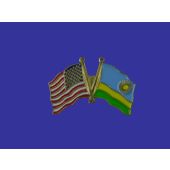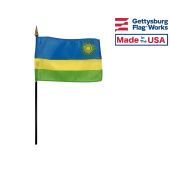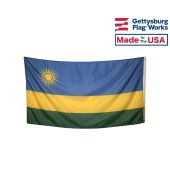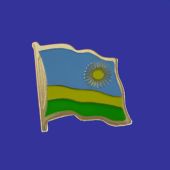Flag of Rwanda
Flag of Rwanda
The flag of Rwanda is currently one of the youngest flags in the world, since it has only been in use since 2001. It is not the first Rwanda flag in history, but it bears very little resemblance to any of the previous flags that have represented the nation.
The flag of Rwanda was adopted on October 25, 2001. It has four colors: blue, green, and two forms of yellow (standard yellow for the middle band and what the Pantone system calls "sun yellow" for the sun); the difference between the two yellows is barely noticeable. The blue band represents happiness and peace, the yellow band symbolizes economic development, and the green band symbolizes the hope of prosperity. The sun represents enlightenment The flag was designed by Alphonse Kirimobenecyo.
- Capital of Rwanda: Kigali
- Area of Rwanda: 24,948 sq. km
- Languages used in Rwanda: Kinyarwanda (official), French (official), English (official), Kiswahili (Swahili)
- Religions in Rwanda: Roman Catholic, Protestant, Adventist, Muslim, indigenous beliefs
Colors and Symbolism of the Flag of Rwanda
The current flag of Rwanda of three horizontal bands of blue, yellow, and green. The blue band at the top of the flag is twice as thick as the other bands, and it features a golden sun on the fly side. The blue stripe is a symbol of happiness and peace, and the thickness of the line serves the emphasize the importance of those ideals. The yellow band is a symbol of prosperity, while the green band represents hope. The sun in the blue band is a symbol of spiritual enlightenment.
History of the Rwanda Flag
It is impossible to separate the history of the Rwanda flag from the political history of the nation itself. Several different flags represented the region during the period when it was dominated by the colonial powers of Europe. The first was the flag of German East Africa, which featured a black cross on a white field with a red square that held five white stars in the canton. That flag fell out of use in the aftermath of the first world war when the territory of Rwanda was transferred to Belgium following the German defeat.
Rwanda did not have a colonial flag while it was part of the Belgian Empire. It was represented by the flag of Belgium, which was a vertical tricolor that influenced the designs of the flags that would come after it. Rwanda became independent from Belgium and adopted a new flag in 1959, and that new flag was an adaptation of the Belgian flag that included the Pan-African colors. The design was used for only two years before it was changed to include a black R in the center of the flag.
That flag represented Rwanda for forty years before it was discarded in the aftermath of the Rwandan Genocide. The government wanted to move on from the past after the event ended, so they adopted a new flag to embody their hope for a better future. That flag came into use in 2001, and it has not changed since.





